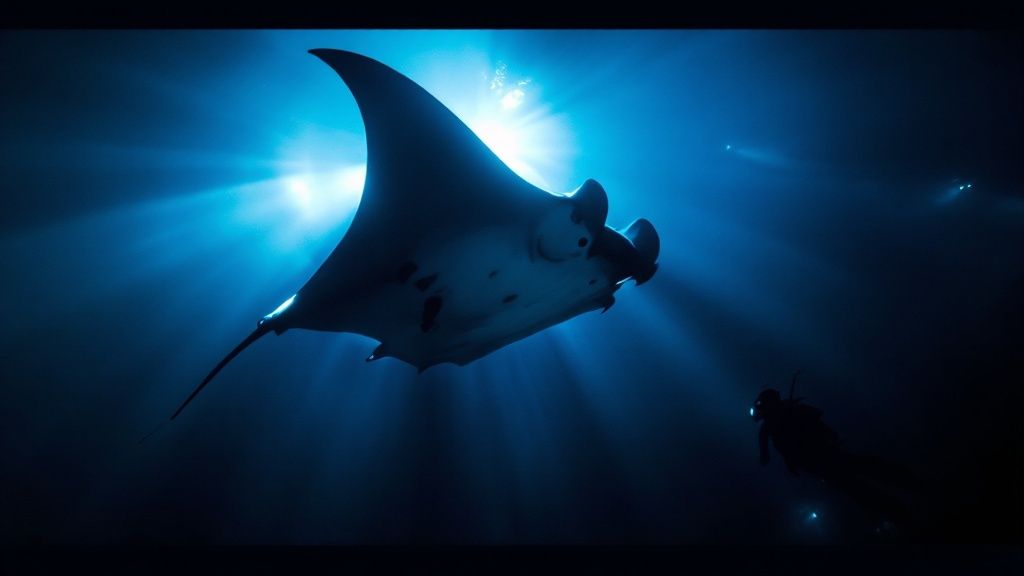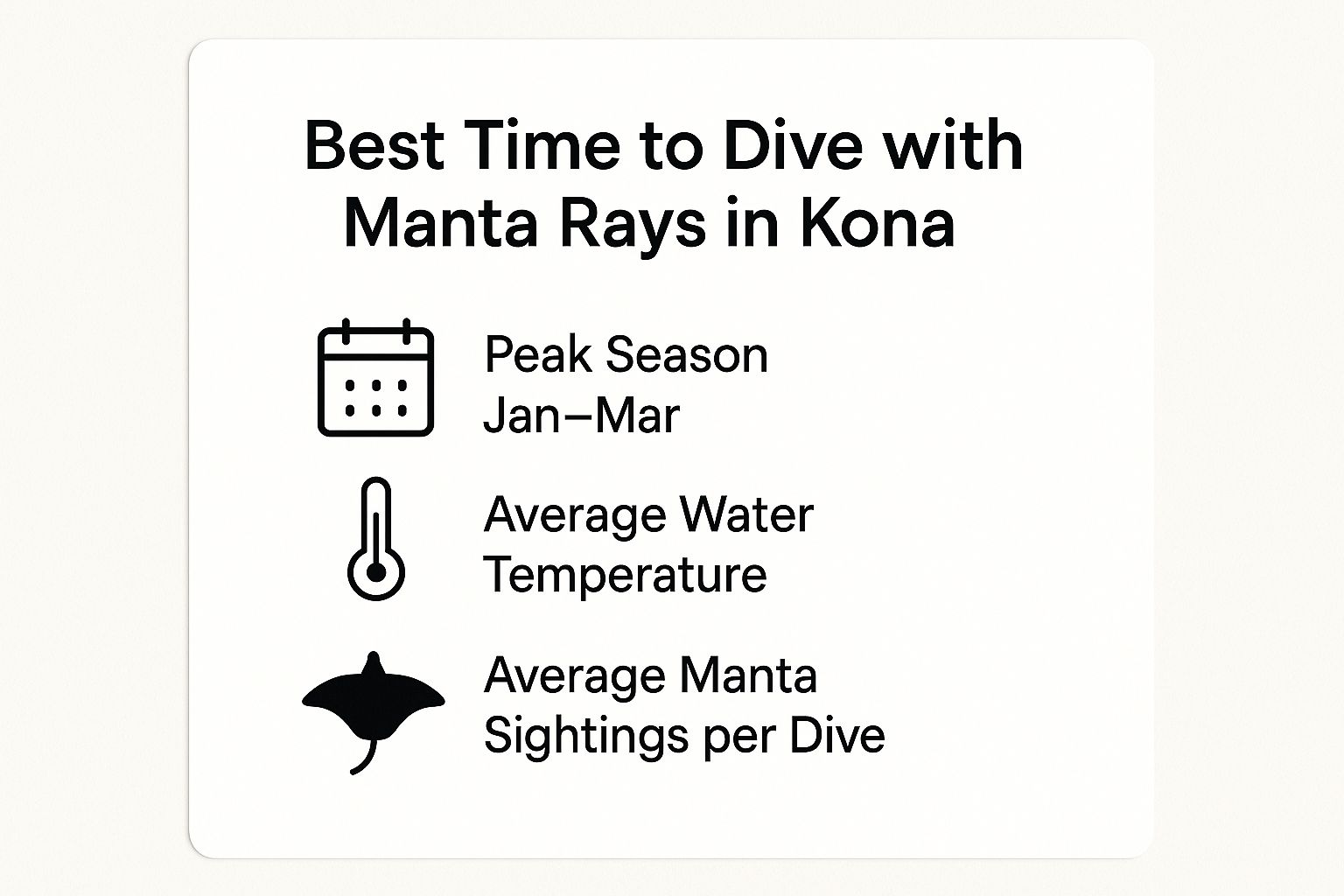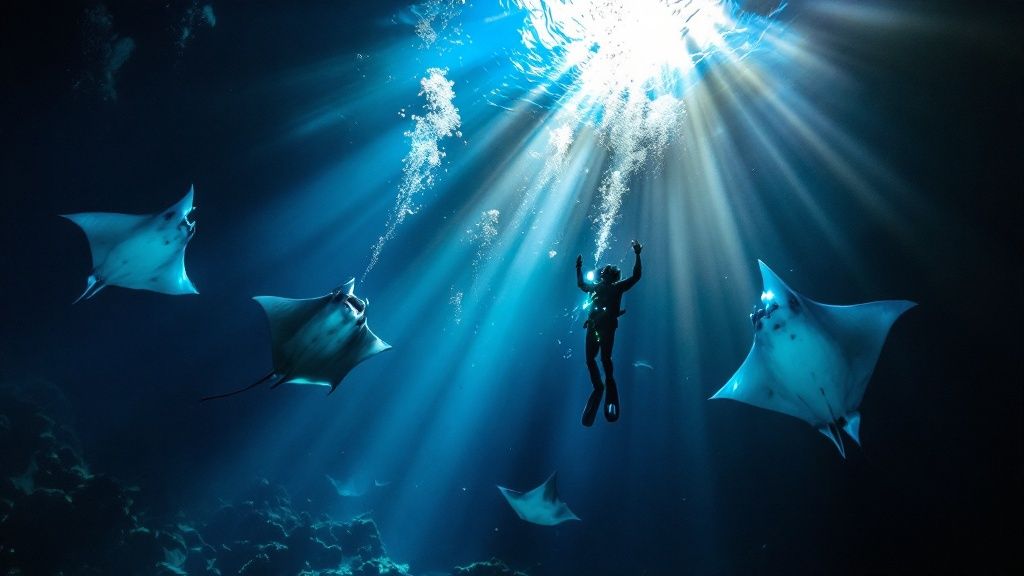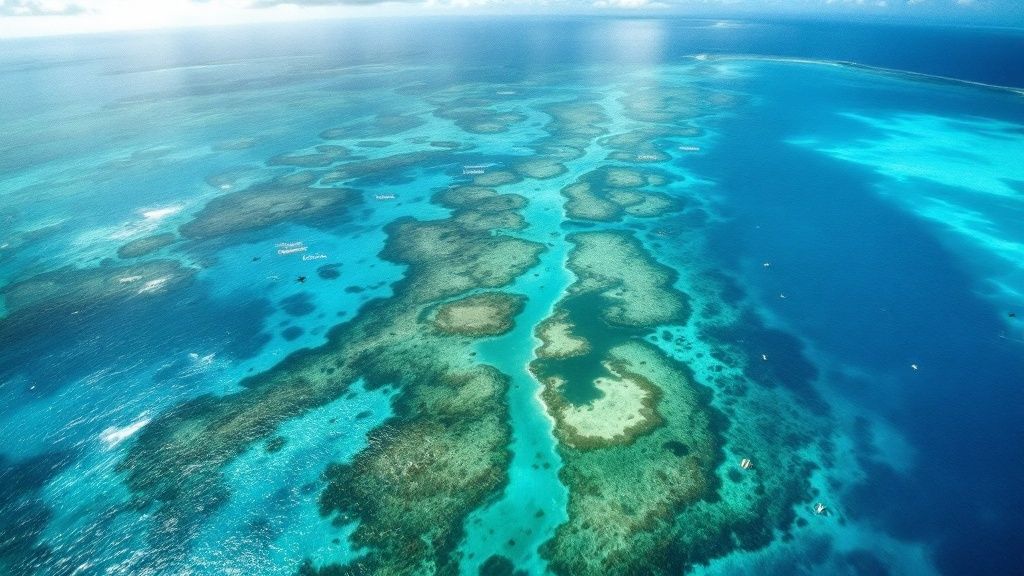The Magic Behind Kona's World-Class Manta Encounters

Kona's reputation as a manta ray haven is no accident. The area boasts a unique combination of environmental factors that create the perfect habitat for these gentle giants, making Kona a top manta ray diving destination. The volcanic underwater topography, with its sloping seabed and deep crevices, provides essential shelter and cleaning stations.
The volcanic activity also enriches the waters with nutrients. This, in turn, fuels the growth of plankton, the manta rays' primary food source. The abundance of plankton establishes Kona as a dependable feeding ground, consistently attracting mantas.
Kona's unique ocean currents further enhance these nutrient-rich waters. These currents sweep plankton up from the depths, creating a veritable feast for the mantas. Popular viewing spots like Manta Village and Manta Heaven are strategically located along these currents. This predictable food source makes these locations ideal for observing these incredible creatures.
Kona, Hawaii, boasts an impressive 80-90% success rate for manta ray sightings. This remarkable consistency attracts approximately 80,000 visitors annually, solidifying Kona's position as a premier location for manta ray tourism. The unique underwater topography and abundant plankton are key contributors to this success. Discover more insights about manta ray encounters.
The Cultural Connection: Respecting the Gentle Giants
Beyond the ecological factors, the cultural significance of manta rays in Hawaiian tradition contributes to Kona's thriving manta ray tourism. Mantas, known as Hahalua in Hawaiian culture, are revered as graceful and intelligent creatures. This deep-rooted respect has fostered sustainable tourism practices, protecting both visitors and the manta ray population.
Sustainable Tourism: Protecting Kona's Treasure
This reverence translates into a strong emphasis on responsible manta ray interactions. Tour operators adhere to strict guidelines, minimizing disruptions to the mantas' natural behavior. Many operators also actively participate in research and conservation initiatives.
This commitment to sustainability ensures the long-term health of Kona’s manta ray population. Visitors can experience the magic of these encounters knowing they are supporting a healthy ecosystem. This fosters a deeper appreciation for these magnificent creatures and their vital role in the Hawaiian environment.
Insider's Guide to Kona's Prime Manta Ray Locations
Kona, Hawaii, offers some truly exceptional manta ray dive sites. Two of the most well-known locations are Manta Village (Keauhou Bay) and Manta Heaven (Garden Eel Cove). Both sites offer unique and magical encounters, but understanding their distinct characteristics can significantly enhance your experience. For those eager to explore Kona’s underwater world, this Manta Ray Kona Snorkel Adventures guide provides further insights into premier manta ray locations.
Manta Village: Keauhou Bay's Gentle Giants
Manta Village, nestled in the calm waters of Keauhou Bay, is renowned for its gentle giants and shallow depths. This makes it an ideal location for beginners and seasoned divers alike. The bay's sandy bottom creates excellent visibility, offering stunning views of the mantas as they gracefully glide through the water. The relatively shallow depth also allows for longer dive times, increasing your chances of interacting with these majestic creatures.
Manta Heaven: Garden Eel Cove's Ballet of Rays
Manta Heaven, located in Garden Eel Cove, offers a different, but equally captivating, experience. Here, the volcanic rock formations create a dramatic backdrop for manta ray viewing. The slightly deeper waters and gentle currents can attract larger groups of mantas, resulting in a mesmerizing ballet of these graceful creatures.
The unique underwater terrain at each site influences manta ray behavior in distinct ways. At Manta Village, the sandy bottom allows divers to settle comfortably and observe the mantas as they perform their feeding rituals. At Manta Heaven, the varied terrain and currents create a more dynamic environment, with mantas often swirling and looping as they feed.
To help you choose the perfect dive site, take a look at the comparison table below:
To help you choose the best dive site for your experience level and preferences, we've put together a comparison table highlighting the key features of each location.
Kona Manta Ray Dive Site Comparison: A comprehensive comparison of the major manta ray dive locations in Kona, highlighting key features of each site to help visitors choose the best location for their experience level and preferences.
| Site Name | Location | Experience Level | Best Time | Avg. Depth | Special Features |
|---|---|---|---|---|---|
| Manta Village | Keauhou Bay | Beginner-friendly | Year-round | Shallow | Calm waters, sandy bottom |
| Manta Heaven | Garden Eel Cove | All Levels | Year-round | Moderate | Volcanic formations, larger groups |
This table provides a quick overview of the key differences between Manta Village and Manta Heaven, allowing you to make an informed decision based on your diving experience and what you hope to see.

This infographic summarizes the optimal diving conditions for observing manta rays in Kona. It includes information about the peak season (January through March), average water temperature (24–26°C), and typical sighting frequency (4–6 mantas per dive).
Beyond the Famous Two: Unveiling Kona's Hidden Gems
While Manta Village and Manta Heaven are renowned, Kona boasts other, lesser-known manta ray dive sites. These hidden gems often offer a more intimate experience with fewer divers. This provides a special opportunity to connect with these gentle giants in a more personal way. Exploring these less-traveled locations reveals a different side of Kona's underwater world. They often feature unique underwater landscapes and diverse marine life, enriching your manta ray dive Kona experience. They truly allow you to dive deeper into the magic of these creatures and their Hawaiian home.
Dive or Snorkel: Crafting Your Perfect Manta Experience

Planning a manta ray encounter in Kona? Choosing between diving and snorkeling is an exciting first step. Both offer amazing interactions, but the experiences are quite distinct. Understanding the nuances of each will help you create the perfect manta ray adventure. For a sneak peek into the diving experience, check out What it's like to go on a manta ray dive.
Diving with Mantas: An Immersive Encounter
Diving provides a uniquely immersive perspective. Resting on the ocean floor, you'll gaze up at these graceful giants as they glide overhead. This vantage point creates a sense of awe, emphasizing the mantas' immense size and graceful movements. You'll also be close enough to see intricate details like their unique markings and the subtle movements of their cephalic fins.
Snorkeling with Mantas: A Surface Dance
Snorkeling, conversely, offers a bird's-eye view. Floating on the surface, you'll witness the mantas' ballet from above. This perspective showcases their impressive wingspan and the elegant choreography of their movements. The contrast of their white underbellies against the dark ocean depths creates a truly spectacular sight. Interested in the best spots? This manta ray dive kona resource reveals Kona's prime manta ray locations.
Making Your Choice: Dive vs. Snorkel
Choosing the right experience depends on your comfort in the water and what you want to get out of the encounter. Proximity is a major factor. Divers typically get much closer to the mantas, while snorkelers have a wider perspective of the scene. Photography opportunities also differ. Divers can capture incredible close-ups, whereas snorkelers can get broader shots that showcase the mantas against the vastness of the ocean.
To help you visualize the differences, we've put together a comparison table:
Diving vs. Snorkeling with Manta Rays: A side-by-side comparison of the diving and snorkeling experience with manta rays in Kona, covering cost, requirements, and the nature of the experience to help visitors make an informed choice.
| Factor | Night Diving | Night Snorkeling | Best For |
|---|---|---|---|
| Cost | Typically higher | Typically lower | Budget-conscious travelers |
| Depth | Requires descending to the seabed | Remains on the surface | Those uncomfortable with deeper water |
| Proximity | Closer to mantas | Wider view of mantas and surroundings | Close encounters vs. overall perspective |
| Comfort | Requires scuba certification | Minimal equipment and training needed | Beginners or those with limited dive experience |
As you can see, there are distinct advantages to each option.
Ultimately, the "best" experience is entirely personal. Both diving and snorkeling offer incredible and unforgettable ways to connect with these amazing creatures. Some find the immersive nature of diving unmatched, while others prefer the simplicity and accessibility of snorkeling. The most important thing is to choose the option that best suits your individual needs and ensures a safe and memorable manta ray encounter.
Understanding the Mysterious Giants of Kona Waters
Manta rays are known for their impressive size and graceful ballet beneath the waves. But beyond their physical presence lies a surprising intelligence. Their cognitive abilities are much more complex than we once thought, making these gentle giants even more captivating. This deeper understanding adds a whole new dimension to the Kona manta ray dive experience.
Manta Ray Intelligence: A Deeper Dive
Manta rays have complex social interactions, especially noticeable during feeding. They display unique behaviors, developing individualized feeding techniques that researchers can recognize. Some mantas prefer a slow, deliberate approach to dining, while others perform acrobatic spins and barrel rolls as they filter plankton. These distinct patterns allow researchers to identify individual mantas, expanding our knowledge of their behavior and social structures. Curious to learn more about night dives? Check out What is a manta ray night dive?
Furthermore, studies indicate that mantas may even recognize individual divers, a testament to their remarkable memory and social awareness. They seem to differentiate between familiar and unfamiliar faces, often approaching those they recognize with apparent curiosity instead of fear. This ability to distinguish between people highlights their advanced cognitive capabilities.
Decoding Manta Behavior: Comfort vs. Stress
Responsible interaction with manta rays hinges on understanding their body language. Subtle cues can tell us whether a manta feels at ease or stressed. Relaxed mantas glide effortlessly, their cephalic fins loosely curled. However, a threatened manta will clamp its cephalic fins tightly against its body and swim away rapidly. By recognizing these signals, we can ensure our presence doesn't disturb these magnificent creatures, allowing us to observe them respectfully.
Tracking the Giants: Unveiling Migration Mysteries
Tracking data has unveiled crucial information about manta ray movements throughout Hawaiian waters. This information is essential for conservation, illuminating migratory paths and preferred habitats. Understanding these patterns helps us protect critical areas and minimize the impact of human activities. Learning about manta ray migrations transforms the dive experience, adding an appreciation for their broader role in the ocean ecosystem. It goes beyond simply observing their beauty, creating a connection to the intricate tapestry of their lives.
Manta Ray Statistics: A Decade of Discovery
Manta Ray Advocates Hawaii's dedicated data collection between 2009 and 2014 has significantly advanced our understanding of manta ray behavior. Their meticulous records provided invaluable insights into these gentle giants, documenting their movements and physiological conditions. For a deeper dive into the numbers, visit Manta Ray Statistics. This research not only helped predict higher concentrations of mantas at specific times and places like Manta Village and Manta Heaven, enriching the Kona manta ray dive experience, but also underscored the importance of recognizing individual mantas and their unique stories.
Crafting Your Unforgettable Kona Manta Adventure

Turning your Kona manta ray dive dreams into a reality takes planning. This guide will help you create an unforgettable experience, covering everything from picking the perfect operator to taking amazing underwater photos.
Choosing the Right Operator: Ethical and Exceptional
Choosing a reputable tour operator is essential for a great manta ray dive experience in Kona. Look for operators dedicated to sustainable practices that put the well-being of these gentle giants first. Responsible operators follow established guidelines, minimizing disruption to the mantas’ natural environment.
Also, seek out operators who contribute to research and conservation. This ensures your adventure benefits the Kona manta ray population in the long run. For instance, Kona Honu Divers emphasizes safety and education, all within a welcoming, family atmosphere.
Timing is Everything: Seasonal and Daily Considerations
Understanding the best times to dive will maximize your chances of a magical encounter. Manta rays are visible year-round in Kona, but certain times offer superior viewing opportunities. Peak season generally runs from January to March, coinciding with plankton blooms that attract large numbers of mantas.
Even outside of peak season, you can still have amazing dives. Daily conditions matter, too. Calm seas and good visibility dramatically improve viewing. Consulting local weather forecasts and tide charts will help you choose the best day for your Kona manta ray dive.
Preparing For Your Dive: Practical Tips From the Pros
Preparing properly will increase your comfort and enjoyment underwater. Guides recommend wearing a thin layer under your wetsuit for warmth, particularly during night dives when water temperatures can be cooler.
Dealing with potential seasickness is also important for a positive experience. Taking preventative steps, like using ginger supplements or over-the-counter motion sickness medication before getting on the boat can be very helpful. Pre-dive deep breathing exercises can also help calm any nerves and promote relaxation.
Capturing the Magic: Photography Tips for Manta Encounters
Capturing stunning photos of your Kona manta ray dive is a must. Knowing a few photography basics can significantly improve your underwater shots. A wide-angle lens is crucial for capturing the mantas’ size and elegant movements.
Adjusting your camera settings for the low light of night dives is also key. A higher ISO and fast shutter speed will prevent blurry images. Positioning yourself slightly below the mantas lets you capture their beautiful underbellies against the illuminated surface. A red filter will restore natural colors lost in deeper water. With these tips, you’ll create breathtaking images that will bring you back to the magic of your manta ray encounter.
Protecting What We Love: The Manta Conservation Story
The incredible manta ray dives in Kona are a unique privilege, not a given. These graceful creatures thrive in a delicate ecosystem, and their continued presence requires ongoing protection. The story of manta ray conservation in Hawaii, from early research to current initiatives, is a fascinating journey of collaboration between marine conservationists, local advocates, and visitors.
Identifying the Individuals: A Groundbreaking System
At the heart of manta ray conservation lies a remarkable identification system. Each manta ray possesses a unique spot pattern on its ventral side (belly), much like a human fingerprint. Researchers and citizen scientists capture photographs of these patterns during manta ray dives in Kona, contributing to a comprehensive database.
This system enables long-term tracking of individual mantas, providing crucial insights into their behavior, migration routes, and population dynamics. This information is essential for assessing the overall health of the manta ray population and evaluating the effectiveness of conservation strategies. Interested in learning more about these dives? Check out this article.
Protecting the Gentle Giants: Bans and Best Practices
Protecting these gentle giants involves specific bans and best practices. Physical contact with manta rays is strictly prohibited to minimize potential harm and avoid disrupting their natural behavior. Responsible tour operators prioritize these guidelines, educating divers and snorkelers on respectful interaction.
Extensive research has catalogued over 290 unique manta rays in Kona, Hawaii. From the first identified manta, aptly named Lefty, to numerous others documented since, the data collected offers valuable insights into their life cycle. With giant manta rays boasting an estimated 40-year lifespan, long-term conservation efforts are vital for maintaining healthy populations. Discover more fascinating facts.
Conservation Success Stories: A Testament to Collective Effort
Thanks to ongoing research and responsible tourism, the manta ray populations in Kona appear stable. This encouraging trend highlights the significant impact of collective action in preserving this precious ecosystem. Continued dedication and collaboration are essential for ensuring the long-term health of these magnificent creatures.
Choosing Responsible Operators: Beyond the Marketing
Choosing responsible tour operators is paramount for supporting manta ray conservation. Look beyond marketing claims and seek companies actively involved in research and conservation programs. These operators contribute directly to the well-being of the manta ray population, going above and beyond simply providing dive experiences.
They often educate guests about the importance of conservation, enriching the experience for everyone involved. As a visitor, your choices directly impact the future of these majestic creatures and their Hawaiian home. By supporting responsible operators and following established guidelines, you become an active participant in the ongoing conservation story, ensuring future generations can witness the magic of Kona's manta rays.
Extending Your Kona Journey: Beyond the Manta Magic
Your manta ray dive in Kona is an unforgettable experience, a true highlight of any Big Island trip. But Kona offers a wealth of adventures beyond these incredible marine encounters. Extending your Kona journey allows you to discover the island’s rich culture and diverse natural beauty.
Exploring Kona's Aquatic Playground
Kona's waters are teeming with life, offering a variety of aquatic adventures beyond manta rays. Consider a snorkeling trip to explore the vibrant coral reefs, or a whale watching tour during the winter months (December to May) when humpback whales migrate to Hawaiian waters. For thrill-seekers, deep-sea fishing excursions provide the chance to reel in pelagic fish like marlin and tuna.
Savoring Local Flavors: Off-the-Beaten-Path Dining
After a day on the water, experience authentic Hawaiian cuisine. Skip the tourist traps and discover off-the-beaten-path restaurants favored by locals. These hidden gems offer a true taste of island life. Try a plate lunch piled high with kalua pig and lomi salmon, or savor fresh poke bowls bursting with Pacific flavors.
Witnessing Nature's Spectacle: Timing Your Visit
Strategic timing can further enhance your Kona experience. Beyond manta rays and whales, other natural phenomena grace the island. From seasonal turtle nesting on the beaches to the rare and captivating coral spawning events, planning your trip around these occurrences adds another layer of magic.
Unveiling Hidden Gems: Local Insights
Connect with Kona's residents to unlock the island’s true essence. Locals can guide you to hidden beaches, secluded waterfalls, and stunning scenic overlooks away from the crowds. These local insights provide a glimpse into the authentic spirit of aloha, transforming your trip into a personal exploration of Hawaiian culture.
Embracing Island Time: Relaxation and Rejuvenation
While adventure is central to any Kona experience, embracing the laid-back island lifestyle is equally important. Spend a day relaxing on pristine beaches, basking in the warm Hawaiian sun. Indulge in a traditional lomilomi massage to rejuvenate your body and mind, allowing you to truly connect with the island's tranquil energy.
By venturing beyond the manta magic, you'll discover the heart of Kona: a blend of thrilling adventures, rich culture, and a profound connection with nature. It’s an experience that will create unforgettable memories.
Ready to embark on the ultimate Kona experience? Book your adventure with Kona Honu Divers today! Explore our diverse dive options and create your perfect Kona getaway.
